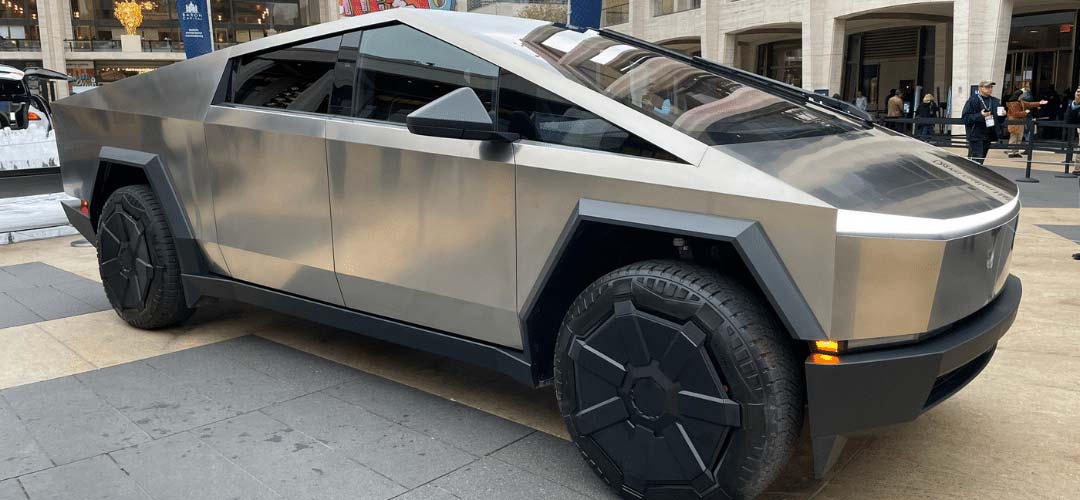
I have been following the evolution of the Tesla Cybertruck since it was first unveiled at a Tesla event in Los Angeles in 2019. 1Production began in 20232 at Tesla’s Gigafactory near Austin, Texas. The Cybertruck’s body is made of stainless steel alloy plates developed by Tesla – its Ultra-Hard 30X Cold-Rolled Stainless Steel.3 4 The battery-powered vehicle uses 124 kWh lithium-ion battery.5 It has an EPA estimate range of 250-340 miles.6 The vehicle also boasts numerous self-driving capabilities, such as autopilot, traffic-aware cruise control, and autosteer. 7 From its stainless-steel panels to its sharp-angled windshield and geometric design, to its advanced technological features – the vehicle is striking.
However, with all these innovative designs and features come new legal challenges that must be explored. Attorneys, insurance companies, and consumers all have a stake in these issues. Stakeholders such as these will want to know what potential claims can be raised, how existing legal concepts apply to such claims, and how they would likely be addressed in court. As such, a proactive application of existing legal concepts to potential areas of litigation will be useful in answering these questions. One area that immediately comes to mind is products liability.
What is Products Liability?
Strict Product Liability is a theory of recovery that exposes defendants to legal accountability for products that are allegedly “defective.” 8 Liability attaches upon proof that the product is defective and a sufficient causal connection between defendant and plaintiff’s injury or for failure to warn. 9 A products liability claim allows a plaintiff to file claims against a broad range of defendants, including all parties involved in the distribution chain, such as manufacturers, wholesalers, distributors, and retailers.
Additionally, the party filing suit need not be the immediate consumer of the product in question. Rather, all that needs to be proven is that the injury suffered by a prospective plaintiff is the type of injury that was reasonably foreseeable. 10 In fact, several cases have found that passengers and bystanders injured by defective automobiles can bring such claims. (See, Elmore v. American Motors Corp. supra, 70 C2d at 586, 75 CR at 656-657; Preissman v. Ford Motor Co. (1970) 1 CA3d 841, 850, 82 CR 108, 113, finding that innocent passengers and bystanders injured by defective automobiles could bring a products liability action.)
We have limited knowledge about accident data or existing lawsuits, since the vehicles were only recently released to the public. However, accidents are inevitable, and there has been at least one reported Cybertruck crash in California involving the famous Beverly Hills hotel sign, though details are unclear.11 12Nevertheless, as more trucks hit the streets, we will likely hear more about the various accidents they are involved in and what role, if any, the vehicle’s design had in the accident. A lawyer tasked with evaluating the potential products liability risks of a Cybertruck would want to consider aspects of its design, safety, and manufacturing process. Properties such as its unique body shape, lithium-ion battery, and self-driving capabilities, among others, are also likely targets to be tested in court.
Angular Design
Besides being visually jarring, the angular design may pose several legal and practical safety concerns. For example, one article from Autoweek opined that the extreme angular design of the windshield causes its A-pillars to impede visibility in the front of the vehicle.13
If Autoweek’s opinion about the windshield is true, the angular design may impose liability on Tesla and others if found to be defective in design. A design is defective if it fails one of two products liability tests known as the “consumer expectation test” and the “risk-benefit test.”14 Under the consumer expectation test, a plaintiff may prove the existence of defect by showing that the product failed to perform safely as an ordinary consumer would expect when used in an intended or reasonably foreseeable manner. Under the risk-benefit test, the plaintiff would need to show a causal connection to their injuries.15 The burden would then shift to a defendant to establish that, given certain factors, the benefits of the challenged design are outweighed by the risk of danger inherent in such a design.16
Here, the consumer expectation test determines what consumers would expect under normal driving conditions. It would be expected that a vehicle’s windshield design would limit obstructions so as to allow as much visibility as reasonably possible and not impede visibility so much as to cause a significantly higher risk to safety as compared to other vehicles.
Stainless Steel Body
Another point of contention about the Cybertruck is the material that makes up its body. The Ultra-Hard 30X Cold-Rolled Stainless Steel is an iconic feature of the Cybertruck. Since there is limited public information regarding accident data for the Cybertruck, it is unclear what role the steel panels may play in an accident. For example, the steel panels might pose a safety risk if the plates are deformed in such a way as to make it more difficult to open damaged doors and escape from a crashed vehicle. However, the alternative might also be true if the steel maintains the structure of the doors such that they remain intact after an accident so as to make escape easier.
Another issue would be whether the stainless-steel body may cause more damage than expected to other vehicles or pedestrians on impact. Under the risk-benefit test, assuming causation is proven, a defendant would have to show that the benefits of these stainless-steel plates outweighed the risk of danger inherent in such a design. Courts would have to consider what benefits an ultra-hard stainless steel body presents to pickup trucks. No other cars on the market feature this design, as stated above. Most other cars have a body made up of a combination of carbon fiber, steel, plastic, and other materials.
Additionally, the unique design of a Cybertruck suggests that its crumple zones are different than those of ordinary vehicles. While organizations such as the National Highway Traffic Safety Administration have yet to weigh in on this matter, experts have raised concerns on the novel design. Reuters spoke to six safety professors and officials that viewed videos of crash tests conducted by Tesla.17 George Washington University auto safety professor Samer Hamdar, for example, raised concerns about what appeared to be limited crumple zones on the Cybertruck. 18
However, crumple zones might not be everything as Hamdar also noted that other shock-absorbent mechanisms might offset what appear to be limited crumple zones. 19 In fact, Tesla themselves commented on the matter.20 In a post on X, Cybertruck’s official account made the following post: “It’s not about the size of your crumple zone, it’s about how you use it. When in a high-speed collision, Cybertruck’s front underbody casting is designed to break into small pieces. This helps reduce occupant impact by absorbing and dispensing energy.”
Nevertheless, it is simply too early to tell whether the difference in design here is safer, equally as safe or more dangerous than other more standard vehicles or whether such differences, if present, would even be significant. Expert opinion and data collected over time would likely play a large role in a court’s assessment of risk versus benefit in this area.21
Lithium-Ion Battery
The Cybertruck uses 124 kWh lithium-ion battery.22 And, while not unique to Tesla, electric vehicle fires are a serious concern. Lithium-ion battery fires are notoriously more difficult to extinguish and can even be toxic. Again, courts would look at consumer expectations regarding fire risk. Consumers likely expect that their vehicle should not spontaneously combust with ordinary foreseeable use. If doing a risk-benefit analysis, courts will consider the benefits posed by electric vehicles over a traditional combustion engine and weigh them against the risks of a battery fire. In addition to data concerning battery fires, policy considerations such as environmental impact may also come into play when weighing the benefits of electric vehicles. Finally, even if the battery does catch fire, the courts will likely want to consider what safety considerations, if any, were made to protect a Cybertruck occupant from that fire.
Self-Driving Functionality
The Cybertruck, like its other Tesla predecessors, comes with a wide array of self-driving features. While often useful and convenient, these features are not perfect. In the last quarter of 2023, the Washington Post reported ten active lawsuits involving Tesla’s autopilot.23 When analyzing the role these features play in such lawsuits, attorneys will again ask what expectations consumers had regarding the Cybertruck’s autopilot features and what risks those features posed versus the benefits they brought.
Regarding consumer expectations, this technology quickly evolving and it is becoming more prevalent every day. As the technology improves and more and more people are exposed to these features, consumer expectations will change and likely vary widely over time. Certainly, the expectations consumers have for self-driving features today will not be the same as those ten years from now. Additionally, the dynamic nature of self-driving features makes analyzing the type of risk posed by this technology especially difficult to pin down.
Conclusion
As we see more Cybertrucks on the road, we will inevitably learn more about the potential products liability and other complaints consumers may have. As for me, I will continue to reminisce with visions of Marty and Doc driving in Back to the Future while Cybertrucks fill the roads.
2Lawler. “Tesla’s Texas plant has built (at least) one Cybertruck.” The Verge. July 15, 2023.
7Cybertruck Owner’s Manual. Autopilot Features. Tesla. 2024.
8D. Strict Liability for Defective Products, Cal. Prac. Guide Pers. Inj. Ch. 2(II)-D
9Id.
10Id.
13Rand. “Tesla’s Cybertruck Breaks All The Design Rules.” Autoweek. December 19, 2023.
14Demara v. The Raymond Corp. (2017) 13 Cal.App.5th 545, 553-554.
15Id.
16Id.
18Id.
19Id.
202024 Tesla Cybertruck. NHTSA. 2024.
21@Cybertruck. X. December 23, 2023.
22Agatie. “Tesla Cybertruck’s Most Important Technical Details Revealed in the EPA Documentation.” Autoevolution. December 5, 2023.
Erik Millan is a general litigation attorney based in San Fernando Valley and Los Angeles area. He received his license in January 2021. As an associate attorney at Kramer, DeBoer & Keane, LLP Erik handled general tort claims focusing on trucking accidents, slip and falls, and errors and omissions claims. Prior to this, he worked as an associate attorney at Webster Kaplan, LLP as a member of the firm’s Labor and Employment Law Practice Group where he handled wage and hour disputes, wrongful termination, discrimination, and PAGA claims. While not currently his primary area of practice, Erik also has general experience in the field of consumer advocacy, including lemon law claims while at Quill & Arrow, LLP, as well as family law and child custody while working as a law clerk at the prestigious law firm of Walzer Melcher, LLP.
Erik graduated from California State University Northridge with dual bachelor’s degrees in Business Administration (cum laude) and Economics (cum laude).
Erik received his J.D. from Pepperdine University School of Law in 2019 where he earned a Certificate in Dispute Resolution as well as a Certificate in Entertainment, Media, and Sports Law. While at Pepperdine, he was treasurer for the Pepperdine chapter of the National Lawyers Guild as well as the school’s chapter of the National Latino Law Student Association.

